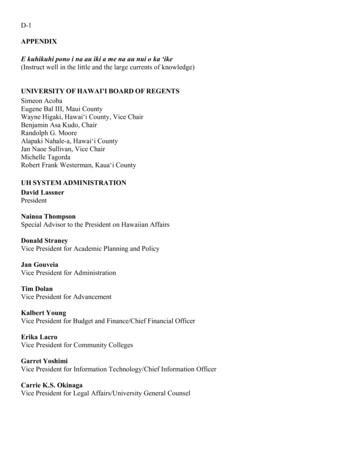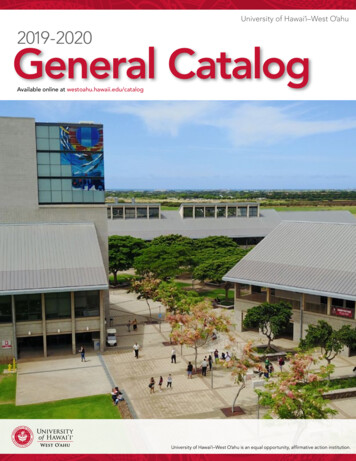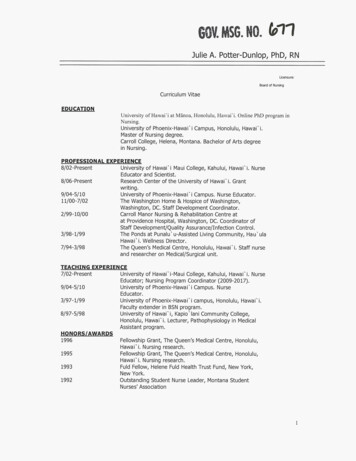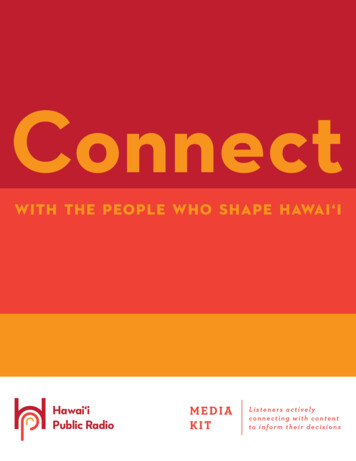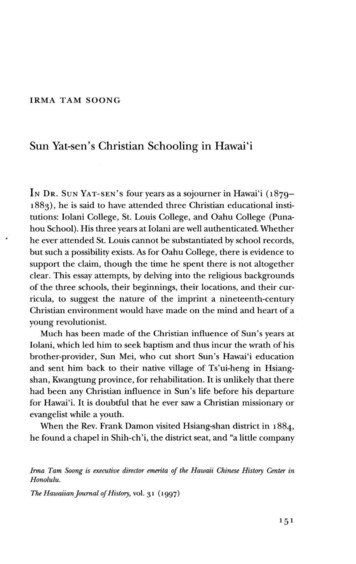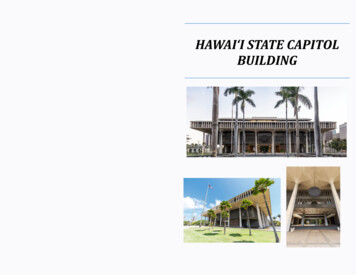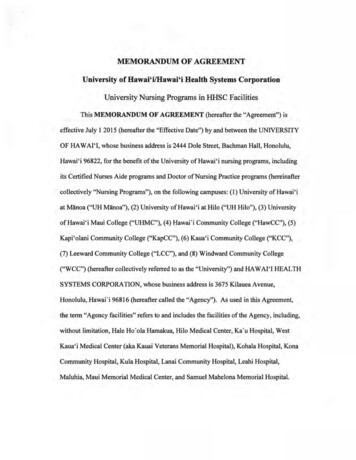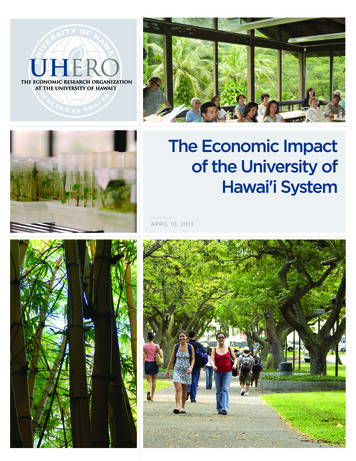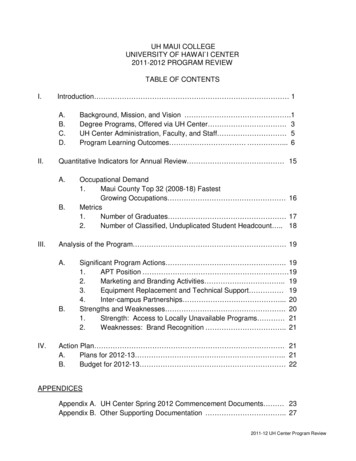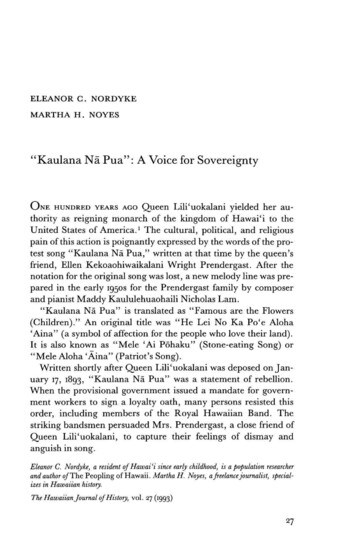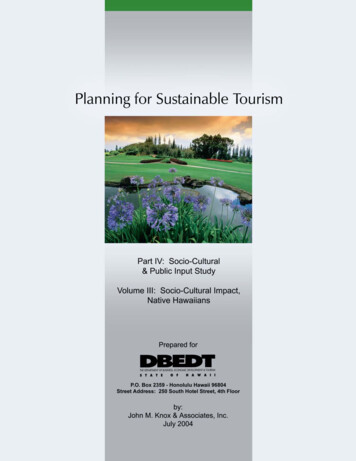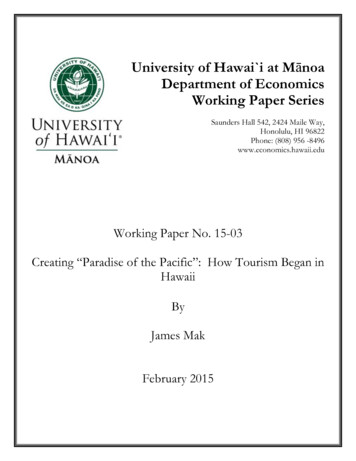
Transcription
University of Hawai i at MānoaDepartment of EconomicsWorking Paper SeriesSaunders Hall 542, 2424 Maile Way,Honolulu, HI 96822Phone: (808) 956 -8496www.economics.hawaii.eduWorking Paper No. 15-03Creating “Paradise of the Pacific”: How Tourism Began inHawaiiByJames MakFebruary 2015
Creating “Paradise of the Pacific”: How Tourism Began in HawaiiJames MakProfessor Emeritus of EconomicsandFellow, University of Hawaii Economic Research OrganizationUniversity of Hawaii at ManoaHonolulu, HI. 96822U.S.A.March 18, 2015AbstractThis article recounts the early years of one of the most successful tourist destinations inthe world, Hawaii, from about 1870 to 1940. Tourism began in Hawaii when faster and morepredictable steamships replaced sailing vessels in trans-Pacific travel. Governments(international, national, and local) were influential in shaping the way Hawaii tourism developed,from government mail subsidies to steamship companies, local funding for tourism promotion,and America’s protective legislation on domestic shipping. Hawaii also reaped a windfall fromits location at the crossroads of the major trade routes in the Pacific region. The articleconcludes with policy lessons.Key words: Hawaii, tourism, tourism developmentAcknowledgement: I thank Dore Minatodani, Senior Librarian, Hawaiian Collection atthe University of Hawaii-Manoa Library, for her kind assistance.1
IntroductionHawaii is a dream vacation destination for millions of people around the world. U.S.News and World Report rates Maui the best vacation destination in the U.S.1 Maui is also ratedfourth best place to visit in the world, the second best place to honeymoon, and the best summervacation destination.2 Kauai is second in the world in having the best beaches; Honolulu isnumber five in best family vacations; and the island of Hawaii (Big Island) is fourteenth in thebest islands category. A group of expert travel professionals recently selected Hawaii as the bestdestination among U.S. states in Travel Weekly’s 2014 “Readers Choice Awards.”3 Hawaii haswon the award eleven times in a row. Not long ago (1999) the National Geographic Travelermagazine included Hawaii in its list of “50 Places of a Lifetime: The World’s GreatestDestinations.” Hawaii has been one of the world’s most popular tourist destinations for a verylong time.In my earlier book, I wrote “Tourism, as it exists today in Hawaii, is essentially a postWorld War II phenomenon.”4 The big increase in tourist numbers came after Statehood in 1959and the start of jet plane travel between Hawaii and the U.S. mainland. Robert Allen’s memoir,Creating Hawaii Tourism, also focuses on the post- World War II period.5 In 1959, Hawaiihosted nearly a quarter of a million visitors. Today, more than 8 million visitors come to Hawaiieach year.1http://travel.usnews.com/Rankings/best usa vacations/http://travel.usnews.com/Rankings/Worlds Best Travel-Weekly-Readers-Choice-Awardswinners/?cid eltrdb4Mak, 2008. p. 13.5Allen, 2004.22
There were tourists in Hawaii before World War II. How far back depends on how onedefines “tourism.” Orvar Lofgren recalls a series of newspaper articles authored by Swedishwriter Carl Jonas Love Almqvist and published in 1840 that explored a relatively novel concept:“What is a tourist?” Tourism is “a new mode of consumption based on the idea of leavinghome and work in search of new experiences, pleasures, and leisure.”6 I agree.7 So does awardwinning author, Elizabeth Becker, who writes: “Tourism is a frivolous pursuit: fun, sometimeseducational in the lightest sense, often romantic, even exotic.”8 The United Nations WorldTourism Organization (UNWTO) does not agree. According to the UNWTO tourism consists of“the activities of persons traveling to and staying in places outside their usual environment fornot more than one consecutive year for leisure, business, and other purposes.”9 By the UNWTOdefinition, the British explorer Captain James Cook and the crew of his two ships, Resolutionand Discovery, were the first tourists to visit Hawaii in 1778.10Louis J. Crampon estimated the number of visitors to Hawaii all the way back to 1800.11Until the middle of the nineteen century, most visitors to Hawaii were merchant seamen andwhalers on shore leave while their ships were resupplied and refitted, often after spending manymonths at sea.12 Those folks were not on holiday. Eminent Hawaii historian Ralph Kuykendallnoted that during the visits of whaling ships each spring and fall “ Honolulu Harbor and6Lofgren, 1999, p. 5.I have suggested that we use the term “visitor” to correspond to the UNWTO inclusive definition oftourist, and the term “tourist” as someone who is traveling primarily for pleasure. Thus, a tourist is also avisitor, but a visitor is not necessarily a tourist. Mak, 2004, pp. 3-4.8Becker, 2013, p. 8.9World Tourism Organization, 1993, p.1.10Kuykendall, 1968, Chapter II.11Crampon, 1976, p. 315.12According to Crampon, over 90 percent of the visitor arrivals in Hawaii between 1850 and 1869 werewhalers. Crampon, 1976, p. 125.73
Lahaina ‘roads’ were crowded by vessels and the dusty or muddy streets and byways of thetowns were filled with sailors cruising about in search of recreation, which to many of themmeant only drunkenness and debauchery. Street brawls were frequent and there were someserious clashes between sailors and the local authorities.”13 Tourism in Hawaii then was vastlydifferent in kind from what it is today.14 In 2013, nearly 84 percent of Hawaii’s visitors cameon pleasure trips, and according to the Hawaii Tourism Authority, Hawaii’s most importanttourist attraction is its “unspoiled natural beauty.”15Mass tourism came to Hawaii after the 1950s, but its humble origin began decadesearlier, in the 1870s, when steamships began to replace sailing vessels in trans-Pacific passengertravel. That story has yet to be told.16 There is very little research available on how successfultourist destinations actually begin. This article provides a narrative of Hawaii’s tourism historyby going backward in time to when it all began. It ends in 1940. Nineteen-forty marks aconvenient break in Hawaii’s tourism history since tourism was suspended during World War IIwhen Hawaii was placed under martial law. All the resources of the Territory were directed toaid the war effort. Tourism would resume after the war, but in a new era, when land-basedairplanes begin to replace steamships in trans-Pacific travel to Hawaii.17One major challenge in writing the early history of tourism in Hawaii is that statistics ontourist arrivals were not tabulated until 1921. The reconstruction of that history must necessarily1314Kuykendall, 1968, p. 93.Kuykendall, 1968, Chapter II.Hawaii Tourism Authority, 1999, pp. 1-10.16Louis Crampon (1976) wrote a lengthy monograph on the history of tourism development in Hawaiiuntil the 1970s. It is descriptive, extremely detailed and highly informative but somewhat thin onexplanation in important places. The monograph was not published and thus not widely distributed.17See Kato and Mak, 2013.154
be largely qualitative. It is “soft” history. I relied heavily on three main contemporary sources.The Hawaiian Almanac and Annual— more popularly referred to as Thrum’s (Hawaiian)Annual— published between 1875 and 1974. Second, the detailed and informative annualreports (1900-1959) of the Governor of (the Territory of) Hawaii to the U.S. Department of theInterior (hereafter referred to as the Governor’s Report). Third, the annual reports of the HawaiiTourist Bureau since 1920.18 Contemporary newspaper stories round out the primary sources.How It All BeganIn a now classic article published in the Cornell Hotel and Restaurant AdministrationQuarterly in 1974, Stanley Plog put forth his theory about how destinations begin and,ultimately, end.19 The first tourists to visit a destination are adventurers whom he called“Venturers”. Not many of them, but they tend to be hardy, independent, and curious soulsseeking new experiences and authenticity rather than familiarity. Tourism in Hawaii began in thesame way. The islands were a big hit among early, curious visitors, and some of them wroteglowing letters and detailed essays about their travel experiences in Hawaii.20 The most famous(or, soon-to-be famous) among them was a thirty-one year old upstart newspaper correspondentand later author and humorist extraordinaire named Mark Twain.Mark Twain arrived in Hawaii on March 18, 1866 as a reporter for the Sacramento Unionwith the intention of staying one month. He stayed four months and one day. During those 12418Unfortunately, most of the reports were not preserved.Plog, 1974.20See, for example, the article by E. S. Baker in Thrum’s Annual, 1877, pp. 27-40. Thrum described it“as being the best descriptive article upon the Islands that has come within our notice and worthy ofpreserving with us.” Baker wrote (p. 27): “[The Hawaiian Islands] possess the general attractivecharacteristics of tropical groups and have a perfection of climate and remarkably charming scenery,which, in many places I have visited, is so delightfully beautiful as to suggest being in an earthlyparadise.”195
days, he traveled extensively throughout the islands and kept detailed notes of what he saw andexperienced which he used to write 25 letters to the Sacramento Union and for which he waspaid 20 per letter.21 Not long after he returned to the mainland, he presented his first publiclecture on the Hawaiian Islands in San Francisco on October 2, 1866. For the next seven yearshe presented variations of that lecture nearly a hundred times to audiences throughout the U.S.and in England. Hawaii received a lot of free publicity. Author Tom Horton opined that “MarkTwain did as much as anyone since Captain Cook did 88 years before him to make the remoteislands known to the rest of the world.”22As much as he loved Hawaii, Mark Twain never returned to the islands he famouslycalled “the loveliest fleet of islands anchored in any ocean.23 But Hawaii would linger as a“haunting passion” during the remaining 44 years of his life.24 In 1899, Mark Twain concluded aspeech in honor of a baseball team that had just returned from the Pacific (including Hawaii)with the now famous “prose poem” tribute to Hawaii:25No alien land in all the world has any deep strong charm for mebut one, no other land could so longingly and so beseechinglyhaunt me, sleeping and waking, through half a lifetime, as thatone has done. Other things leave me, but it abides; other things21Day, ed., 1975; and Horton, 1996, p. 98.Horton, 1996, p. 102.23At html; and Horton, 1996.25In 1908, the Hawaii Promotion Committee presented to Mark Twain a koa mantelpiece “in recognitionof his friendly interests in the islands. He it was who years ago wrote so graceful a prose poem tribute toHawaii that added years but intensify its depth of meaning.” Thrum’s Annual, 1909, p. 178.226
change, but it remains the same. For me its balmy airs are alwaysblowing, its summer seas flashing in the sun; the pulsing of itssurfbeat is in my ear; I can see its garland crags, its leaping cascades,its plumy palms drowsing by the shore, its remote summits floating likeislands above the cloud wrack; I can feel the spirit of its woodland solitudes,I can hear the plash of its brooks; in my nostrils still lives the breath offlowers that perished twenty years ago.New York Times writer, Lawrence Downes, advises that if you are looking for something to read“to enrich your visit to Hawaii What you want is Mark Twain.”26Another visitor, R. S. Smith wrote about the warm hospitality of Hawaii’s people:“Nothing more genial, nothing more genuinely polite than the Hawaiian welcome ever greetedthe strangers to these shores.”27 Today, Hawaii’s famous hospitality is known as the “AlohaSpirit.”One of my favorite early testimonials was written by E. Ellsworth Carey:28The tourist and sightseeker who roams the earth over, seekingfor the new, the strange and the marvellous, should give someattention to the many and ever varied attractions of the HawaiianIslands justly termed the “Paradise of the Pacific.” The climate ismild, equitable, delightful; any degree of temperature from the semitropical to the everlasting snows may be experienced. The sea-26Downes, 2006.Thrum’s Annual, 1884, p. 50.28Thrum’s Annual, 1893, pp. 88-89.277
scented breezes are health-giving and refreshing. Ozone abounds.Bathing in the emerald-tinted sea is a luxury. The elysian moonlightentrances the traveler; the grand vistas that are spread out from thetops of the craggy precipices are almost sublime.The scenery is varied; it is beautiful and sublime by turns.It is always changing. Sailing along the island coasts, the visitorholds sky-reaching cliffs, verdure-coverers and cloud-covered. Fromthe empyrean heights dash silver streams in countless numbers. Thelights and shadows fill the soul of an artist with unspeakable longings.At the foot of the giant battlements dash the white surges of the Pacific,and their roar is echoed from a thousand lava caves.An epitome of the world’s scenery is found in Hawaii. Therecliffs and caves; grand canyons and measureless waterfalls; spoutingcaves and singing sands; bottomless and rivers of lava.The crowning attraction is, doubtless, Kilauea; this volcanocontains an everlasting lake of fire and force, which has been thethe delight and wonder of thousands. It is always changing, and theweird and awful sights of that wonderful caldron have been the subjectof countless letters, descriptions, writings and odes.But its mystic grandeur can never be conceived; its appealingbeauty and unearthly spell can never be imparted. Stand over Kilauea,as the shadows of night fall o’er the scene, and behold the indescribable,unknowable, and incomprehensible. “Be still, and know that I am God.”8
No traveler can visit the different islands of the Hawaiian groupand not feel amply repaid. He will receive a lasting experience, and theodor of the flowers and the flash of waters on a coral strand will abidewith him forever.Hawaii may have been the “Paradise of the Pacific”, but tourists must first get there.Tourism means travel, and travel requires transportation. During most of the nineteenthcentury, visiting Hawaii meant crossing the vast Pacific Ocean on a sailing ship from SanFrancisco, a distance of some 2,100 miles.29 At the height of the California gold rush (around1850) diminutive schooners and brigs dominated the Hawaii trade.30 Carrying freight was theirmain business though passengers were also accommodated. Before steamships “our businessdealings with that port [San Francisco], which comprised more than all others combined wasdependent upon sailing vessels, which served also for passenger accommodation and mailopportunities, often weeks apart in arrival. Tourist travel was not encouraged thereby.”31 Itwould require the arrival of regular steamship service to get tourism going in Hawaii.Steamships provide greater speed and more predictable schedules than sailing vessels.29During the peak of the whaling era, Hawaii had developed stronger commercial and, thus, shipping tieswith the east coast than with the west coast of the United States. The settlement and growth of Californiaand Oregon and the discovery of gold in California helped to shift the pattern of transportation from theeast coast to the west coast. The Civil War in the United States accelerated the shift of Hawaiian trade andshipping from the Atlantic to the Pacific side of the United States. Kuykendall, 1966, pp. 16-17.30Thrum’s Annual, 1931, p. 27.31Thrum’s Annual, 1923, p. 39. In 1861, 35 ships carrying mail arrived in Honolulu from San Francisco;33 sailing vessels and 2 steamships. The average passage time was 14 days and 1 hour. Passage timesranged from 8 days and 17.5 hours to 24 days for sailing vessels; the average was a little over 14 days.The two steamers (each) arrived in 11 days. Regular packets took between 13 to 14 days. (PacificCommercial Advertiser, February 28, 1862.) Average passage time on steamships would fall to around 7days in the 1880s and to 5 days on the fastest passenger steamers by the 1930s.9
Mark Twain arrived in Honolulu on the steamship Ajax. Ajax’s inaugural round tripvoyage from San Francisco arrived in Honolulu on January 27, 1866 with 68 passengers.32After two round trips, the California Steam Navigation Company decided against offering furthervoyages because the service was unprofitable without government subsidy. However, a yearlater the U.S. postmaster general contracted with the California, Oregon and Mexico SteamshipCompany to provide monthly mail service between San Francisco and Honolulu for a period of10 years. The steamship Idaho arrived in Honolulu under the provisions of the mail contract onSeptember 17, 1867. That marked the beginning of regular steamship service between the U.S.mainland and Hawaii.33In 1871, the California, New Zealand, and Australia Steam Navigation Companyinaugurated steamship service between San Francisco, Honolulu, the South Pacific, Australia andNew Zealand. That trial was short-lived. The last sailing from Sydney was in 1873.34 The routewas taken over by the British flag Australasia and American Mail Steamship Company, Ltd., butthat venture ended after one year.35In 1875 the Pacific Mail Steamship Company resumed steamship service between SanFrancisco and Australia with a layover in Honolulu. From San Francisco, ships made stops inHonolulu and Auckland, New Zealand en route to Sydney, Australia, and vice versa. With thecompletion of the transcontinental railroad across the U.S. (in 1869), it was faster for England tocommunicate with its “Colonies” in the South Pacific using rail and steamer service via San32Pacific Commercial Advertiser, February 3, 1866.Kuykendall, 1966, p. 170.34Stindt, 1982, p. 51.35Stindt, 1982, p. 51.3310
Francisco and Honolulu than via the Suez Canal.36 It was also a cheaper and more comfortableroute and thus favored by British settlers traveling between their homeland and the Colonies.37For steamship companies, providing service to the Land Down Under was lucrative only becauseof government mail contracts; for the Pacific Mail Steamship Company, it meant a 210,000annual subsidy for 10 years.38While freight and mail were the most important cargo between Australia and SanFrancisco, steamships also carried sizable number of passengers. For example, the 11 steamshipsen route to San Francisco from Sydney and Auckland in 1875 carried a total of 1,121 passengers,10 to Honolulu, 227 from Honolulu, and 884 were in-transit. The 12 vessels en route toAuckland and Sydney from San Francisco carried a total of 855 passengers, 264 to Honolulu, 24from Honolulu, and 567 were in-transit. Thus there were many more passengers passing throughHonolulu than passengers going to Honolulu.39Pacific Mail maintained its service between Australia, Honolulu and San Francisco for anuneventful 9 years; the service ended after its mail contract expired on October 1, 1885. OceanicSteamship Company stepped up to fill the void. Fred Stindt summed up its history as follows:“The history of the Oceanic Steamship Company is a story of dogged determination to expandAmerican shipping to the South Seas and the “World Down Under”—New Zealand and36Kuykendall, 1966, p. 172.“It has been noticed, frequently, too of late, how gradually and surely this route is gaining favor withthe traveling world as against the Suez line; this being one of continuous pleasure and instruction,restoring the invalid and adding vigor to the strong; while the other is one of decided discomfort andcontinuous anxiety, being both unbearably hot and less or more unhealthy.” Pacific CommercialAdvertiser, July 20, 1878.38Worden, 1981, p. 12.39Thrum’s Annual, 1876, p. 55.3711
Australia.”40 Founded in 1881 by Hawaii Sugar King Claus Spreckels (and a few others),Oceanic entered the San Francisco-Honolulu trade in 1882 with a chartered steamship; thenexpanded its service in 1883 with two new 3000-ton steamships.41 After Pacific Mail andSteamship Company ended its Australia-San Francisco service, Oceanic signed a five-year 200,000 per year mail subsidy contract with the New South Wales and New Zealandgovernments to continue the service to Australia and New Zealand. The U.S. governmentcontributed money toward that contract, and between 1888 and 1891 the Hawaiian governmentcontributed 1,500 per trip.42 As with the Pacific Mail and Steamship Company, “ the singlefactor that kept the ships sailing was subsidy.”43Hawaii benefited financially from government mail subsidies to trans-Pacific steamshipcompanies as passengers passing through Honolulu could play tourist for a day during theirseveral hours of layover in Honolulu. Of the 11 ships that stopped in Honolulu en route to SanFrancisco in 1875, the average layover was 19 hours; only 3 ships stayed at least 24 hours, thelongest layover was 30 hours, the shortest was 6 hours. Of the 12 ships bound for Auckland andSydney, not one stayed at least 24 hours; the average layover was 17 hours, the longest was 21hours and the shortest was 8 hours.44 The economic value of one-day tourism did not gounnoticed. Thrum’s Annual, 1894 observed that during a very difficult year of 1893:40Stindt, 1982, p. 51.Stindt, 1982, p. 53. The American-Hawaiian Steamship Company, incorporated in 1899, also servedthe Hawaii trade focusing primarily on the Hawaii-West Coast-East Coast route. It was strictly a freightcarrier and did not carry paying passengers. Cochran and Ginger, 1954.42Stindt, 1982, p. 53.43Stindt, 1982, p. 51.44Thrum’s Annual, 1876, p. 55. These layover times remained pretty much unchanged over the years.The Governor’s Report to the Secretary of the Interior in 1906 noted (p. 41) that “All through steamers as4112
While trade in general has felt depressed this past year Stillwe have benefitted somewhat by the extra through travel bythe frequent steamers to and fro between the occident and orient,as also in the new line established between the Colonies andVancouver via this port ”At the end of the day (flower) lei-decked departing passengers were sent off with Hawaiianmusic provided by the Royal Hawaiian Band. “Steamer Days” would later be extended to alldeparting ships in the Honolulu-San Francisco route “to give the local boat with departingresidents and tourists as good a sendoff.”45 There was a negative side. School officials foundtruancy rates rose on Steamer Days as many boys skipped school to sell San Francisconewspapers to steamship passengers.46Through passenger counts at Honolulu varied from year to year; there were 1,707 throughpassengers in 1875. The average for 1880-81 was 3,239; 4,026 for 1890-92 and 5,833 for 189294.47 Much of the increase was due to passengers traveling to Asia from ports on the west coast.For example, in 1881, 2881 passengers passed through Honolulu of which 911 (31.6 percent)were traveling to China from San Francisco, Callao (Peru) and Oregon.48 A decade later in 1891,Honolulu received 4,984 through passengers, of which 2,503 (50.2 percent) were travelinga usual thing, so arrange their schedule as to arrive at Honolulu in the morning, stay in port from 8 to 30hours.”45Thrum’s Annual, 1901, pp. 108-109.Pacific Commercial Advertiser, October 29, 1900.47Schmitt, 1977, p. 451.48Thrum’s Annual, 1882, p.29.4613
between China or Japan and San Francisco, British Columbia or Mexico.49 Honolulu, being atthe “Crossroads of the Pacific”, was a natural layover for ships to buy provisions, fresh water,and fuel for steamships.The signing of the Reciprocity Treaty between the U.S. and the Kingdom of Hawaii in1876, which permitted sugar grown in Hawaii to be shipped to the U.S. duty free, greatlystimulated sugar production and overall economic activity in the islands. Demand for shippingincreased sharply. More shipping was required to transport raw sugar from the outer islands toHonolulu and then on to the U.S. mainland. More shipping was needed to carry more goods toHawaii as well. Shipping was the lifeline of Hawaii. Thrum’s Annual, 1881 observed “ thatwe import nearly everything that we eat, drink, wear, or use, and San Francisco is our principalsource of supply. We are producers and exporters of sugar, rice, and a few other minor articles,but importers of all else.”50 More shipping service meant potentially more visitors and tourists.With direct service between the U.S. mainland and Honolulu and through trans-Pacificservice via Honolulu, Hawaii was able to tap into two potential tourist markets—tourists boundfor Hawaii as their final destination and travelers in transit to other destinations beyond Hawaii.Thrum’s Annual, 1888 expressed its optimism for this opportunity as follows:51The two or three lines of sailing packets that used to suffice, with theirpassages of from ten to twenty or more days from San Francisco, arenow strengthened by direct monthly steamers of the Oceanic Steamship49Thrum’s Annual, 1893, p. 35.Thrum’s Annual, 1881, p. 63.51Thrum’s Annual, 1888, p. 65.5014
Company, as also the monthly call, both ways, of their Australia, NewZealand and San Francisco line of steamers, all of which vessels make thetrip in seven days between this port and San Francisco, and often timesless. These boats fitted with every comfort for passengers, and officeredby courteous and experienced men, make it a pleasure trip in every sense ofthe word. The natural consequences has been to encourage in a marked degreethe travel of tourists and others, whether in pursuit of health, pleasure orprofit. And it is but the beginning of what these islands are destined to attractwhen the facts of our climate and natural attractions become known to theintelligent public.Optimism on tourism’s future in the islands still had to be tempered by the reality thatHawaii was not there yet.52 The number of destination-Hawaii visitors were disappointingly low.The fact that Hawaii has been the most extensively written about of allthe groups in the Pacific reflects rather upon the reading world when ouradvantages, as presented year after year, seemed to be ignored by solarge a proportion of the world’s sightseers and tourists, as well as seekersfor investments and developers of new enterprises, or latent industries.With all our steamship and sailing packet opportunities, giving us almostweekly communication with San Francisco, monthly with the Colonies,52Thrum’s Annual, 1892, p. 134; see also the 1885 issue, pp. 74-7515
frequently with China and Japan, it is the tourist “in transit” who predominatesin sight-seeing around the islands—accidental visitors as it were—ratherthan planned parties to spend a certain number of weeks or months here,to learn the comforts of tropical life as shown in Honolulu, either in itswell appointed hotels, or amid its attractive homes, or to see the greatestof all “lions”, the renowned volcano of Kilauea.Hawaii’s first wave of tourists, following the random visits of adventurers and curiosity seekers,were mostly through passengers from steamships on their way to somewhere else.Obstacles to Tourism DevelopmentWhy were there not more tourists coming to Hawaii as their final destination?Apparently the chief cause of the past failure to make Honolulu and otherplaces on the group adequately appreciated, as wintering resorts for invalids,or those who dread the rigors of winter in the eastern and northern portionsof the United States, has been because of the failure to properly advertisethe manifold attractions of the group, or even to set forth, specifically, the costof the trip to these islands and of a sufficiently long sojourn here tomake acquaintance with the scenery, the climate and the agricultural developmentof the group.5353Thrum’s Annual, 1885, pp. 74-75.16
Cost was an important factor. Beginning in 1885 (through 1904) Thrum’s Annual beganto publish a special section on information for tourists. From the Annual, one can get a prettygood idea of what it would have cost to take a pleasure trip to Hawaii. For example, the 1885issue showed that a round trip steamship ticket (good for three months) between San Franciscoand Honolulu cost 125. The one-way voyage would take 7 days. Lodging (including meals) atthe Hawaiian Hotel in Honolulu cost 3 per day. (Cheaper accommodations were available inmany private homes.) On Oahu “the bathing beach of Waikiki, the beautiful valleys of Manoaand Kalihi, the famous Pali, the picturesque land-locked bay known as Pearl River—all of theseand a score of other places are within easy access of town.” A four-day trip around part of Oahuby carriage or horseback cost 30 to 60. “Suburban” excursions would cost 3 to 10 each.Tours to the Neighbor Islands by steamships were also available through one of two inter-islandsteamship companies. For example, an all-inclusive tour of Hawaii Island, including a visit tothe Kilauea Volcano, was estimated to cost 75. A one week tour to Maui that included visits toHaleakala, the largest extinct volcano in the world, the “grandly gloomy valley of Wailuku, [and]the extensive plantation and sugar mills of Spreckelsville” could be purchased for 50. Thesame price for a one week tour of Kauai, “including a visit to the ‘Sounding Sands’ of Waimea,the world-famous sugar estate of Lihue, and the lovely water falls and fern glens of the ‘GardenIsland’s many valleys.”One visitor to Hawaii in 1884 suggested a visit to Hawaii from San Francisco shouldallow three weeks in Hawaii and two weeks for ocean passage.54 The estimated total cost wouldbe 270, including round trip steamship fare ( 125), room and board ( 70), inter-island54Pacific Commercial Advertiser, April 10, 1884.17
steamship fare (including meals) ( 25), horse rentals (
Working Paper Series Saunders Hall 542, 2424 Maile Way, Honolulu, HI 96822 Phone: (808) 956 -8496 www.economics.hawaii.edu Working Paper No. 15-03 Creating "Paradise of the Pacific": How Tourism Began in Hawaii ! By James Mak February 2015
